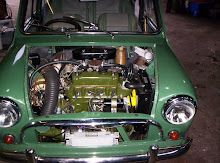The most suitable lubricant to use in the grease gun is one of the modern multi-purpose lithium-based greases, which are suitable not only for the steering connexions, swivel pins, propellor-shaft nipples, brake cables and pivots, but which also should be used for packing the rear wheel hubs. If it is blended with molybdenum disulphide, so much the better.
Each grease nipple should be wiped before the gun is applied, to avoid any risk of grit being forced through the nipple into the bearing.
If the nipple is dented or otherwise damaged it is a simple matter to unscrew it and fit a replacement, which can be obtained from a B.L.M.C. dealer. In an emergency, however, it is possible to obtain a satisfactory seal, even on a damaged nipple, if a piece of cheesecloth or other light fabric is first placed between the nipple and the end of the grease gun.
Many owners are unaware that every lubrication nipple contains a small spring-loaded ball valve which prevents the grease from escaping from the bearing. If a "worm" of grease exudes from the nipple when the grease gun is removed this valve is not functioning correctly and it is advisable to renew the nipple as soon as possible.
It is an advantage when greasing each steering swivel to jack up that side of the car until the front wheel is clear of the ground. This will allow grease to reach the thrust faces of the bearings that carry the weight.
Early in the life of the Mini the greasers on the inboard propellor-shaft splines, which were difficult to reach, were rendered unnecessary by packing the joints with a special long-life grease. The lubricator on the gear linkage, at the back of the engine, now qualifies as the only nipple which is rather inaccessible but the latest recommendation is that the linkage needs lubrication only at major overhaul periods, unless unusual stiffness develops in the gear change.
A further example of improvement in servicing is the substitution of nylon ball cups for the metal-to-metal type previously used at the ends of the steering tie rods. The later design of joint does not require lubrication and is not therefore fitted with a grease nipple.
Having disposed of the general aspects of lubrication one can now turn to one or two points that deserve a little clarification when tackling the jobs listed under the various mileage headings in the Maintenance Schedule.
Sunday, 18 October 2009
Grease-gun Lubrication
Labels: grease, gun, lubrication
Posted by Info Mini Cars at 04:03
Subscribe to:
Post Comments (Atom)


0 comments:
Post a Comment